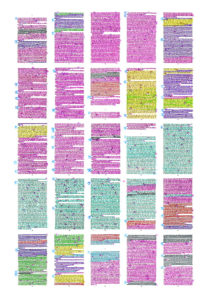Regan Platt is an offline marketing intern at Author Solutions, the world leader in supported self-publishing. She is currently a senior at Indiana University where she studies English. Regan is in Indiana University’s Liberal Arts Management Program, an honors level interdisciplinary program that incorporates Kelley School of Business courses with a liberal arts education.
1. Color Coordination
How to: When you’re working on a puzzle it helps to know what the big picture looks like. This is how you can think about color coordination. This editing technique begins with printing out a copy of your manuscript. Sometimes it is best to only print one main section if your piece is lengthy. The next step is to categorize the printed section into different categories.
For example, if your piece is about three friends (Lucy, John, and Chris) the categories may look like this: Chris and Lucy scene, Lucy alone, John and Lucy scene, Chris and John scene. Lastly, you will assign a color to each category and highlight that section with its specified color.
Following the example above, all the ‘Chris and Lucy’ scenes may be colored with red while the ‘Lucy alone’ scenes are colored in blue. Once you’ve colored in all your scenes, the final step is to hang up your pages in order on a wall or spread them out on a table.
Result: Looking at your work, you should start to see patterns. What color is most prominent? Is it a category that you want to take up most of your work? Maybe you’ll notice that some categories are lacking, does one color seems very sparse? Looking at your writing in a visual way will provide a new perspective that can help realign the manuscript with your final vision.
2. Text Swap
How to: The text swap technique is all about looking at your piece through new eyes. While writing, it is likely that you’ve been looking at the same font style for literally days or months. After a while, all the words and stanzas start to blend together. To counteract this, try putting your manuscript in a new font. If you feel really stuck, try an excessive font like Comic Sans. A variation of the text swap is to change the color of your font.
Result: This sudden visual change will force you to take time reading your work. The words will look different and instantly mistakes you’ve glossed over before will jump off the page. Text swap is a good technique to practice throughout the writing or editing process anytime you feel like you’re losing sight of your work.
3. Aroma Editing
How to: Aroma editing is a somewhat wacky technique that is meant to help a writer reach a new state of mind. To practice this technique you need a scent producing source such as a candle or oil-diffuser. It is helpful to choose a scent that either goes thematically with your writing or is particularly unique. Once you’ve chosen an aroma make sure the room you plan to edit in has been thoroughly perfumed. Now it’s time to sit down, enjoy the smell, and get to editing.
Result: Editing within a scented room can elevate your mind and provide a stimulant that will help you perceive things in a fresh way. Additionally, the scent you choose can also aid you mood. For example, lavender can alleviate stress and a citric scent such as orange can aid self-esteem.
4. Read Along
How to: Reading along is a fairly common technique, although it takes a bit of bravery to test out. To do a read along, you will first have to find a willing assistant. Your assistant should be someone you trust because their job is to read your work out loud to you. While they read out loud, you will follow along and make notes and edits. This editing technique may seem nerve-wracking, but it is exceptionally successful.
Result: Hearing your story out loud in someone else’s voice is an amazing and eye opening experience. Suddenly, you will hear sentences read in a way you never expected. The reader’s intonation may differ from what you’ve been hearing in your mind. You will notice moments that make you cringe but originally seemed genuine. It will allow you to find sections that felt overworked but now when being read sound successful. If there’s a stanza you feel is a problem spot, have it read over a few times and see what you hear.
Archway Publishing is always looking for content for its blog. If you’re an Archway Publishing author and would like to share an idea for a guest blog post, please tweet the Archway Publishing Twitter account @ArchwayPub or send us a message at the Archway Publishing Facebook page.
